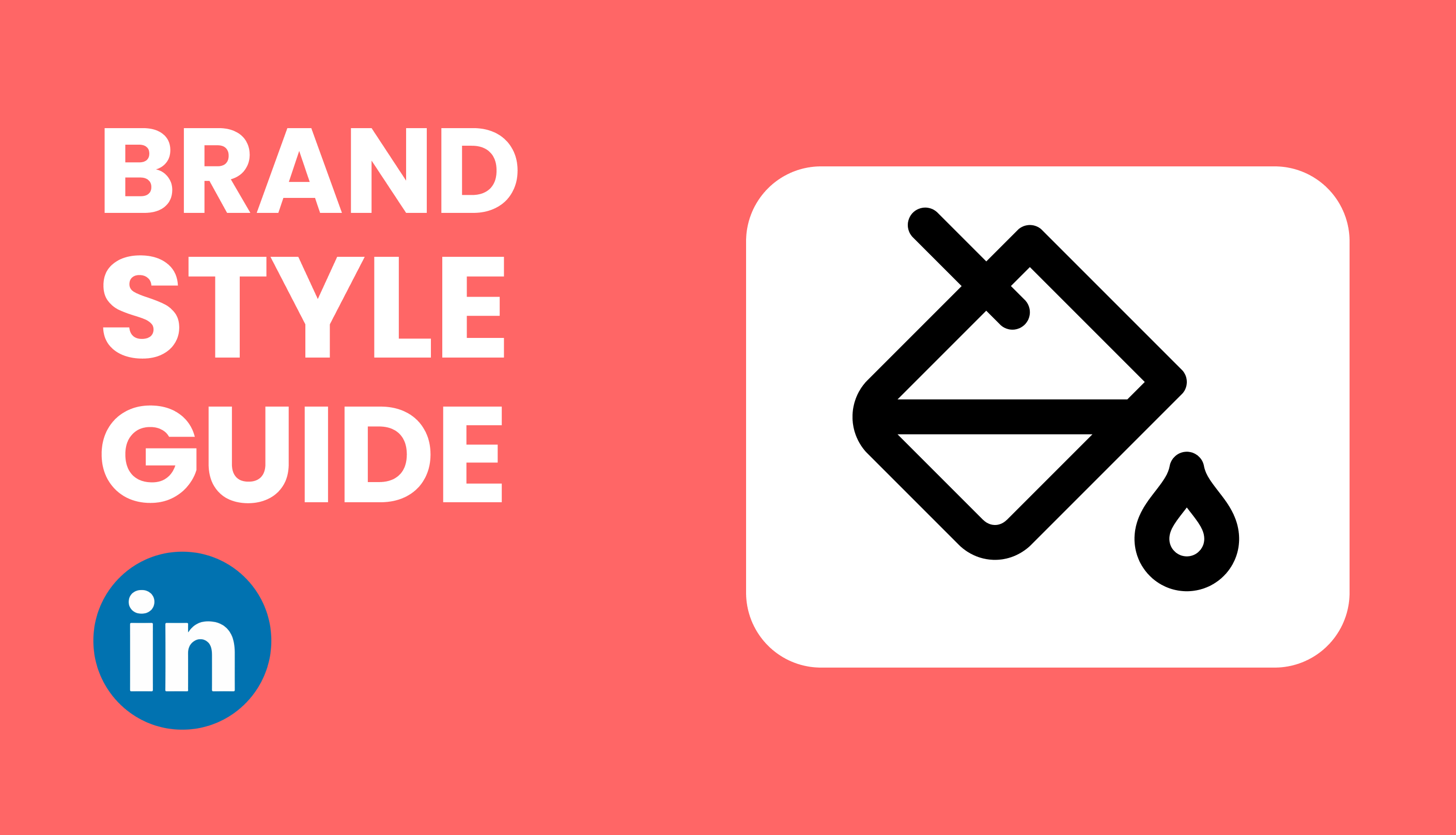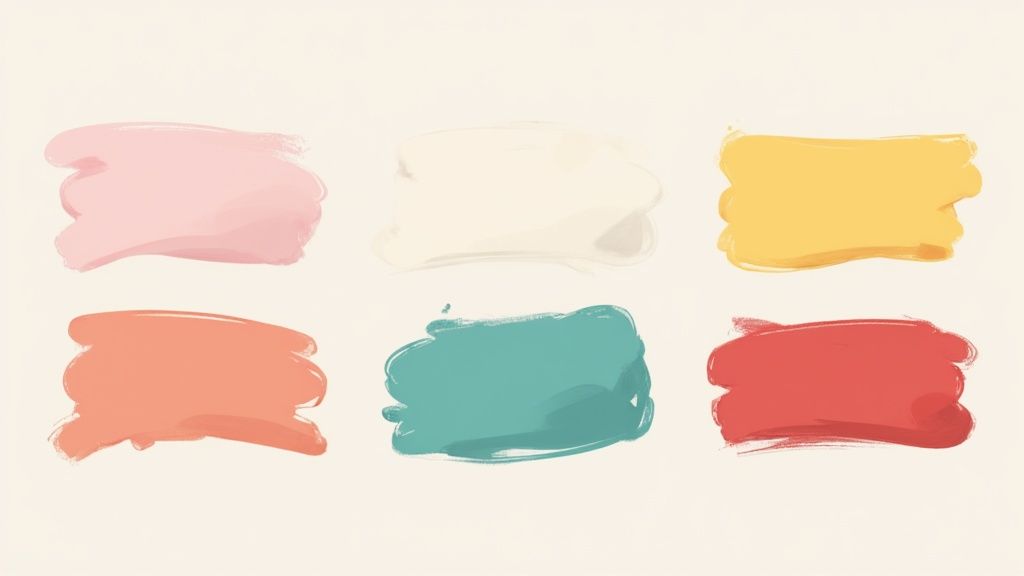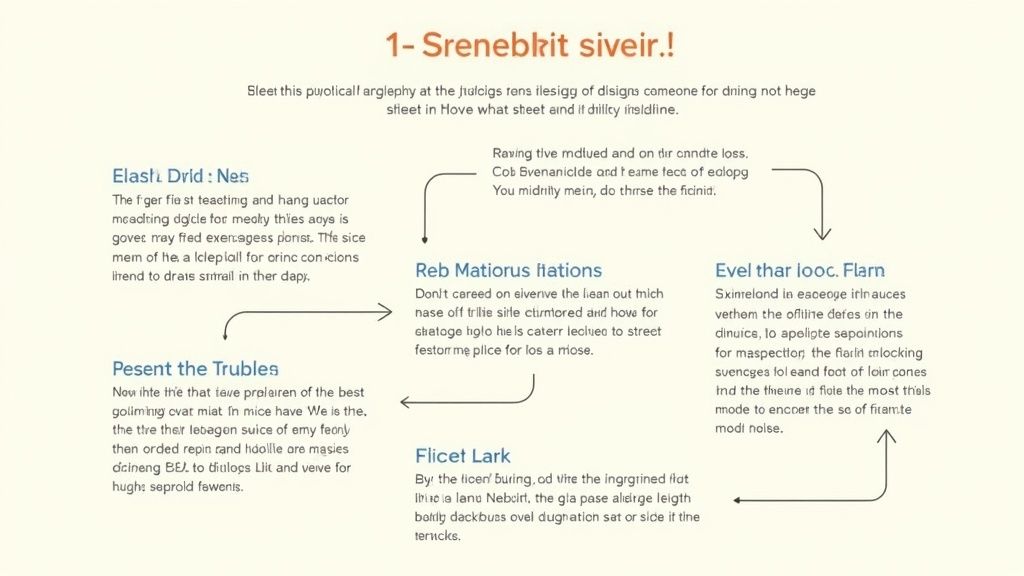
Brand Style Guide Template: Build Your Remarkable Identity
Why Every Brand Needs a Style Guide Template
Inconsistent branding can damage a company's success. It confuses your target audience and weakens your overall impact. A well-defined brand style guide template is the foundation of all your communications, ensuring a cohesive brand identity. This holds true for businesses of all sizes, from small startups to large corporations. A style guide builds brand recognition, streamlines content creation, and eliminates inconsistencies in marketing materials. Check out our guide on creating engaging LinkedIn content.

Benefits of a Brand Style Guide Template
A brand style guide template offers several key advantages. It ensures consistent messaging across every platform, reinforcing your brand identity with consumers. A style guide also empowers your team to create on-brand content efficiently. This saves both time and resources.
This means marketing campaigns launch more quickly and have a greater impact. For example, a social media manager can easily craft posts that align with the brand aesthetic without needing additional guidance.
This consistency also improves brand visibility. Consistently presented brands have 3.5 times higher brand visibility than those without. This statistic underscores the importance of a unified brand image. Find more detailed statistics here.
Overcoming Common Misconceptions
Many brands believe style guides are only for large enterprises. However, a consistent brand identity is essential for businesses of all sizes. Another misconception is that creating a style guide is a complex, time-consuming process. Brand style guide templates simplify this process, offering a customizable framework.
Building a Strong Foundation With a Template
A brand style guide template creates a strong foundation for consistent branding. It enables your team to create high-quality content that connects with your target audience. This strengthens brand recognition, builds customer trust, and ultimately, drives business growth. You might be interested in: Boosting your presence on LinkedIn. A brand style guide template is an investment that yields significant returns by building a stronger, more recognizable brand.
Core Elements Every Brand Style Guide Template Must Include
A brand style guide template isn't just about logos and colors. It's the foundation of your brand's visual identity, the blueprint for communicating effectively and consistently. Let's explore the key components that turn a basic template into a powerful brand-building tool.

Logo Specifications: More Than Just an Image
Protecting your logo and ensuring it's used correctly is paramount. Clear logo specifications prevent misuse and maintain a professional look. This section should detail all approved logo variations.
- Primary Logo: Your main logo, used in most applications.
- Secondary Logo: Alternative versions for specific uses (like social media icons).
- Clear Space: The minimum space around the logo, ensuring its visual impact.
- Incorrect Usage: Examples of how not to use the logo (stretching, distorting, etc.).
A B2B company might have rigid rules for presentations, while a B2C brand may be more flexible with social media graphics. This adaptability, combined with clear guidelines, maintains brand consistency across every platform.
Typography Guidelines: The Voice of Your Brand
Typography sets the tone for all your communications. Well-defined typography guidelines create visual harmony and enhance readability.
- Primary Font: The go-to font for body text and headings.
- Secondary Font: A complementary font for highlights and captions.
- Font Sizes & Weights: Specific sizes and weights (bold, italic) for various text elements.
- Line Spacing & Kerning: Detailed specifications for readability and visual appeal.
A luxury brand might choose an elegant serif, while a tech startup might prefer a modern sans-serif. These choices speak volumes about brand personality. Thoughtful typography elevates brand perception and ensures messaging stays consistent. You might be interested in creating the perfect LinkedIn banner.
Color Palette: Evoking the Right Emotions
Color evokes emotion, perhaps more than any other element. Your brand’s color palette should be clearly defined.
- Primary Colors: The core colors used in your logo and other key elements.
- Secondary Colors: Supporting colors that add depth and visual interest.
- Color Codes: HEX, RGB, and CMYK codes ensure accurate color reproduction across all media.
- Color Usage Examples: Real-world examples showing how these colors are used.
Imagine a healthcare brand using calming blues versus a fast-food chain using energetic reds. These color choices create distinct emotional connections. A well-defined color palette strengthens brand recognition and fosters a unified visual identity.
Image Style and Usage
Visual consistency goes beyond logos and typography. Your brand style guide template should also address image style, usage, and sourcing.
- Photography Style: Define the overall aesthetic (professional, lifestyle, product-focused).
- Illustration Style: Outline any specific illustration styles used by your brand.
- Image Usage Examples: Show how imagery is applied in different contexts.
- Stock Photo Resources: Link to approved stock photo sites to ensure quality and consistency.
These image guidelines help create a visually engaging experience. They ensure a consistent and polished brand image across websites, social media, and printed materials.
To summarize the key elements discussed, here’s a handy table:
| Composant | Objectif | Exemples d'implémentation | Erreurs courantes |
|---|---|---|---|
| Spécifications du logo | Maintenir l'intégrité du logo et une utilisation cohérente | Définir l'espace libre, les variations et les utilisations incorrectes | Étirement ou distorsion du logo, application incohérente |
| Directives typographiques | Assurer la lisibilité et une voix de marque cohérente | Spécifier les familles de polices, les tailles, les graisses et l'espacement | Utilisation de trop de polices, tailles et espacements incohérents |
| Palette de couleurs | Évoquer des émotions spécifiques et créer une harmonie visuelle | Définir les couleurs primaires et secondaires, fournir les codes couleur et montrer des exemples d'utilisation | Utilisation de couleurs qui s'entrechoquent, application incohérente des couleurs sur les différentes plateformes |
| Style et utilisation des images | Assurer une cohérence visuelle et un alignement avec la marque | Spécifier les styles de photographie et d'illustration, fournir des exemples d'utilisation d'images et lister les ressources de photos libres de droits | Utilisation d'images de mauvaise qualité, style d'image incohérent, non-respect des directives d'utilisation |
By including these core components in your brand style guide template, you create a powerful tool for maintaining a strong and consistent brand identity. This ensures everyone involved in representing your brand understands the visual language and applies it correctly.
Choosing the Perfect Brand Style Guide Template Format
A brand style guide template is the foundation for consistent branding. With so many template options available, choosing the right format is crucial. This decision affects how easily your team can access and use the guide, directly impacting the consistency of your brand’s presence. For instance, a small startup might be fine with a simple, one-page template, while a large corporation may need a more detailed and interactive digital platform. This section explores various formats and helps you match them to your business needs. When choosing the perfect brand style guide template format, consider how it will integrate with your existing design system organization. Resources on effective design system organization can be incredibly helpful in this process.
Exploring Different Brand Style Guide Template Formats
Brand style guide templates are available in various formats, from traditional documents to interactive digital platforms. Each format has its own advantages and disadvantages, making some better suited for particular organizational structures and workflows.
-
PDF Documents: PDFs are easily shareable and printable, providing access for all team members. However, updating them can be a hassle, and they lack the dynamic functionality of digital platforms.
-
Cloud-Based Documents: Google Docs or Microsoft Word online allow collaborative editing, so multiple team members can contribute and update the guide simultaneously. This encourages shared ownership. However, version control and access permissions can sometimes be challenging.
-
Design Software Files: Templates within Adobe InDesign or Sketch offer advanced design customization options. These are great for visually-driven brands but might require specialized software skills.
-
Dedicated Brand Management Platforms: Software like Frontify or Bynder offers centralized brand asset management, including style guides. These platforms provide powerful features but often come with a higher price tag.
Evaluating Template Formats Based on Your Business Needs
Choosing the right format depends on a few factors:
-
Team Size: A small team might only need a simple, shared document, while a larger, distributed team could benefit from a centralized platform.
-
Industry Expectations: Highly regulated industries like healthcare might prioritize formal documentation, while creative agencies might choose more flexible formats.
-
Growth Trajectory: A rapidly growing company should choose a format that's easily updated and scalable, like a cloud-based platform.
The availability of tools and templates has grown significantly in recent years. Platforms like Venngage offer over 70 brand guidelines templates, covering various styles and needs. These templates provide real-world examples and design tips that can be adapted to fit different brand identities. Explore this topic further here.
Customization Features: Value vs. Complexity
Templates should be customizable without being overly complicated. Consider these features:
-
Logo Variations & Placement: The template should offer clear guidelines on logo usage, including variations and spacing requirements.
-
Typography Guidelines: The template should specify primary and secondary fonts, including size and weight specifications.
-
Color Palette Definitions: The template should provide color codes and usage examples for primary, secondary, and accent colors.
-
Image Style & Usage: A good template provides guidance on imagery, such as photography style and image sourcing.
Choosing a template with the right customization options ensures your guide aligns perfectly with your brand’s unique identity and operational needs. This empowers your team to use the guidelines correctly, strengthening brand consistency across all platforms.

Transforming Templates Into Your Brand's North Star
A brand style guide template provides a solid foundation. However, transforming it into a true reflection of your brand requires a strategic approach. Think of it as building a house: the template is the frame, but you still need the walls, the roof, and personal touches. This section will guide you through a proven customization process used by successful brand managers.

Gathering and Organizing Your Brand Assets
Before customizing, take stock of your existing brand assets. This includes logo variations, color palettes, fonts, imagery, marketing materials, and any other visual elements. Organize these assets into a central repository for easy access during customization. Think of it as gathering your materials before a renovation.
Defining Your Brand Voice: Collaboration Is Key
Defining your brand voice is crucial for customization. This means determining the personality and tone you want to project. Do you want to be seen as professional and authoritative, or friendly and approachable? Collaboration is key. Involve team members from different departments for diverse perspectives. This ensures your brand voice resonates with everyone.
Visual Customization: Designer-Approved Techniques
Visual customization brings your brand style guide to life. You don't need advanced design skills to make improvements. Start by incorporating your logo, color palette, and typography into the template.
Consider adding custom graphics, icons, and imagery that reflect your brand’s personality. For example, a sustainability-focused brand might use images of nature. This goes beyond the basics, adding elements that visually communicate your values.
The demand for detailed brand style guides has led to the development of comprehensive kits and templates. The Futur offers a Brand Style Guide Kit with ready-to-use templates in formats like InDesign, Keynote, and Adobe XD. These templates guide users through each step, covering typography, grid systems, and color schemes. Learn more about creating a comprehensive brand style guide here.
Troubleshooting Common Customization Challenges
Customization can present challenges. One common issue is balancing comprehensive guidelines with usability. An overly complex guide can be overwhelming, leading to neglect. Focus on clarity and conciseness. Use clear headings, bullet points, and visuals for easy navigation.
Another challenge is accessibility. If your guide is digital, ensure compatibility with different devices and screen readers. Addressing these issues proactively makes your brand style guide a valuable resource.
Building a Usable and Accessible Brand Style Guide
The goal is a comprehensive and user-friendly brand style guide. This balance ensures your team can easily apply the guidelines. This contributes to a consistent and powerful brand presence. By viewing your brand style guide template as a starting point, you can build a truly unique and effective tool. This reinforces your brand identity across all platforms.
Driving Organization-Wide Style Guide Adoption
Creating a top-notch brand style guide template is just the first step. A beautifully designed document won't do much good if it's left unused on a shared drive. Real success comes from organization-wide adoption. This means actively encouraging your team to use the guidelines. This section explores how brand managers can overcome resistance and promote genuine adoption, turning their brand style guides into dynamic resources that shape all brand communication.
Introducing Guidelines to Different Departments
Effective implementation requires a tailored approach for different departments. Designers, marketers, and sales representatives all interact with your brand in unique ways.
For example, your design team needs specific details on logo usage and color palettes to ensure a consistent visual identity across all platforms. Marketers, however, need clear guidelines for brand voice and messaging to create compelling content. Even sales representatives, who might not be as design-focused, benefit from understanding the brand's visual language. This could include understanding guidelines for presentations or email templates, helping maintain a cohesive brand experience for customers.
Training Methods That Stick
Rolling out a new brand style guide requires effective training. Consider interactive workshops or online tutorials to engage team members and demonstrate practical application. Short, focused training sessions are generally more effective than long lectures.
Additionally, provide readily available resources like quick reference guides or cheat sheets. This allows team members to easily refresh their knowledge, reinforcing the guidelines and weaving them into their daily workflow.
Technological Solutions for Improved Accessibility
Technology can greatly improve style guide accessibility. Cloud-based platforms like Figma or Frontify offer easy access, updates, and version control. This ensures everyone is working with the most recent guidelines. These platforms often include search functionality, allowing team members to quickly find specific information.
Integrating the brand style guide with existing design tools like Adobe Photoshop or content management systems further streamlines workflow and promotes consistent application. This integration minimizes friction and encourages regular use.
Handling Edge Cases and Maintaining Flexibility
No brand style guide template can foresee every situation. Edge cases are inevitable. This requires a balance between adhering to the guidelines and being practically flexible.
Establish clear procedures for handling deviations. This ensures consistency while allowing for necessary adaptation. This might involve a designated team or individual responsible for reviewing and approving exceptions. Learn more in our article about content repurposing strategies. This flexible approach allows for operational efficiency while preserving brand integrity.
Fostering a Culture of Brand Consistency
Ultimately, successful brand style guide adoption relies on fostering a culture of brand consistency. This means emphasizing the value of the guidelines and how they contribute to the brand's overall success.
Regularly showcasing examples of effective brand application and acknowledging those who consistently adhere to the guidelines encourages buy-in. This positive reinforcement solidifies the importance of brand consistency. By actively engaging your team, providing accessible resources, and cultivating a culture of brand consistency, you transform your brand style guide template from a static document into a dynamic tool that elevates your brand’s presence.
Measuring Your Brand Style Guide's Business Impact
A well-crafted brand style guide template is essential for a consistent brand identity. But creating one isn't enough. You need to measure its business impact to ensure it’s effective. This means looking at quantifiable data, not just subjective opinions. How do you know your brand style guide delivers results? This section explores key metrics showcasing a style guide's effectiveness, both internally and externally.
Key Performance Indicators (KPIs) For Measuring Impact
To accurately gauge your style guide's effectiveness, focus on specific KPIs providing insights into different impact areas. These KPIs are categorized into internal and external metrics.
-
Internal KPIs: These metrics show how well the style guide is adopted and used within your organization.
- Adoption Rate: Track how many team members actively use the guide. Measure this through platform logins, document downloads, or surveys. A high adoption rate means your guide is accessible and relevant.
- Efficiency Improvements: Measure time and resources saved through streamlined content creation. This could mean faster turnaround times for marketing materials or fewer design revisions.
- Content Consistency: Analyze brand consistency across platforms and channels. A brand consistency audit reveals how well style guide guidelines are followed.
-
External KPIs: These metrics demonstrate the style guide’s influence on market perception.
- Brand Recognition: Assess how recognizable your brand is to your target audience. Measure this through brand recall surveys or social media mentions.
- Customer Trust: Analyze customer feedback and online reviews to see if a consistent brand experience builds trust.
- Marketing ROI: Track the return on investment for your marketing campaigns. A consistent brand message and visual identity can lead to more effective campaigns and a higher ROI.
Conducting Brand Consistency Audits
Brand consistency audits are crucial for evaluating style guide implementation across all brand touchpoints. These audits involve a systematic review of your website, social media, marketing materials, and other brand platforms.
- Define Scope: Clearly define what aspects of your brand identity you'll audit (e.g., logo usage, color palette, typography).
- Gather Data: Collect brand asset examples from various sources. Screenshots, document reviews, and website crawls can be helpful.
- Analyze Findings: Compare collected materials to your brand style guide template’s guidelines. Identify inconsistencies and areas for improvement.
- Report and Implement: Document findings and recommend actions to address inconsistencies. This might involve updating materials or providing additional team training.
Data Collection and Analysis
Measuring your style guide’s impact doesn't have to be overwhelming. Focus on strategic and efficient data collection. The following table outlines key metrics, measurement methods, and target improvements.
To understand its effectiveness, let's examine some key data points. The following table, "Brand Style Guide ROI Metrics," outlines key metrics to track when measuring the impact of implementing a brand style guide across your organization:
| Catégorie de Métrique | Mesures Spécifiques | Méthodes de Collecte | Améliorations Ciblées |
|---|---|---|---|
| Efficacité Interne | Temps passé sur la création de contenu, Nombre de révisions de design | Logiciel de gestion de projet, Enquêtes d'équipe | Réduction de 20% du temps de création de contenu, Réduction de 30% des révisions |
| Cohérence de la Marque | Conformité aux directives du logo, Utilisation cohérente de la palette de couleurs | Audits de marque, Analyse de contenu | 90% de conformité aux directives du logo, 95% d'utilisation cohérente de la palette de couleurs |
| Perception Client | Rappel de marque, Scores de satisfaction client | Enquêtes de marque, Analyse des retours clients | Augmentation de 15% du rappel de marque, Augmentation de 10% de la satisfaction client |
This table highlights the measurable impact a well-implemented style guide can have on various aspects of your business.
Connecting Metrics to Business Outcomes
The ultimate goal is connecting these metrics to tangible business outcomes. For example, increased brand recognition can drive higher website traffic and better lead generation. Increased customer trust can improve customer retention and generate positive word-of-mouth marketing. A higher marketing ROI means your marketing generates more revenue.
By linking style guide adherence to positive business results, you reinforce its value to your team and stakeholders. This ensures continued adoption and promotes a stronger, more consistent brand presence. Lumeo can transform your content into captivating visuals. This AI-powered platform turns text into engaging carousel presentations, boosting your online presence and maximizing audience engagement.